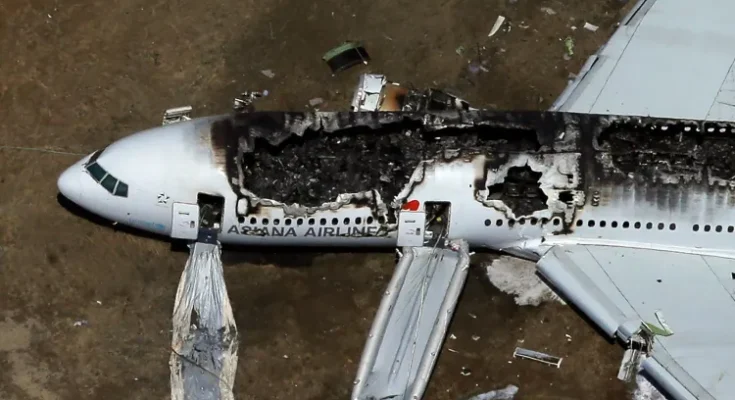It seems like 2014 has been an especially bad year for plane safety, with the disappearance of Malaysia Airlines Flight 370, the shooting of MH17 over Ukraine, and the recent crashes of TransAsia Airways and Air Algerie planes.
But it’s important to remember that thousands of airplanes take off every day. Comparatively speaking, plane crashes are quite rare. Indeed, flying is one of the safest ways to travel, despite the impression you might get from watching CNN.
Here are some of the basics about how frequently crashes happen, when, where, and why.
1) Either almost everyone survives a plane accident or almost no one does
 A thorough US government analysis of 1983–2000 plane accidents found that most accidents have really high survival rates of 81 to 100 percent. But in a handful of accidents, just 0 to 20 percent of people survive.
A thorough US government analysis of 1983–2000 plane accidents found that most accidents have really high survival rates of 81 to 100 percent. But in a handful of accidents, just 0 to 20 percent of people survive.
2) Flying is much safer than driving
Joseph Stromberg laid out the case in a recent Vox post: “The data on the risk of driving versus flying commercial is unequivocal. Plane crashes and attacks get a lot of attention, but they’re extremely rare, and claim a much lower number of lives on a per-mile basis. . . . In 2012 (also the most recent year for which we have data), zero people died on commercial US flights. This includes international flights by US airlines. (There were 432 deaths on privately flown planes, along with 15 accident-related fatalities on air ambulances and cargo planes.) . . . Even figuring conservatively, the risk of death as a result of from driving a 100 mile trip as compared to flying it is at least an order of magnitude higher.”

3) Fear of flying might lead to more deaths on the road
Right after 9/11, people were flying less and driving about 3 percent more. As Joseph Stromberg covered in this story, psychological researcher Gerd Gigerenzer noted that this extra driving was responsible for 353 excess deaths in the three months following 9/11. It’s not a huge effect, and it would be interesting to see if it could be picked up following other disasters, too.
In October, November, and December of 2001 (squares), fatal traffic accidents deviated significantly from the five-year average (circles) Gerd Gigerenzer
4) Planes are crashing less often and killing fewer people
The worst year for plane deaths was 1972, according to this International Business Times analysis. The data do tend to fluctuate from year to year, but it’s clear that we’re not living in the most dangerous time for flying.

5) Deaths per plane passenger have been going down
The Economist did a nice analysis of recent trends and came to this conclusion: “Over the past four decades fatalities on aeroplanes—be it from accidents or terrorism—have declined even as the number of travellers has increased almost ten-fold.” This chart also shows that the majority of deaths are because of accidents, not terrorist attacks.
6) At least 88 planes have disappeared since 1948
This count is from the Aviation Safety Network, an independent, private initiative that maintains an extensive database of airliner, military, and corporate accidents across the world. All 88 flights went completely missing without a single trace. “In these cases not a single piece of wreckage, oil slick or body has been found,” the site says.
7) Jet planes crash most during takeoff and landing
 This Reuters chart shows fatal accidents on commercial jets from 2003 and 2012, and the trend is pretty clear. Even though planes spend a lot of time cruising at high altitude, the most dangerous part is at the very end and very beginning. That’s why they’re always telling you to put your tray table away.
This Reuters chart shows fatal accidents on commercial jets from 2003 and 2012, and the trend is pretty clear. Even though planes spend a lot of time cruising at high altitude, the most dangerous part is at the very end and very beginning. That’s why they’re always telling you to put your tray table away.
8) Flying in North America is way safer than in Africa or the former Soviet Union
When crashes are adjusted for the number of flights, North America and Europe are pretty safe places to fly. As this Forbes story points out, flying is more dangerous in some African and former Soviet nations.
9) The safest part of the plane might be the back. Or maybe not.

Crash survival rates. Popular Mechanics
In 2007, Popular Mechanics went through 36 years of fatal US crashes to try to find where the people who survived them sat. They concluded that the back of the plane was better. However, because such crashes are so rare, there were only 20 crashes available for analysis. And that makes it unclear if this is just a statistical fluke in a small data set.
The magazine’s story also included a quotation from the FAA, which said that there’s no way to know which area is safest. But since it’s unlikely that sitting in the back will harm you, you may as well go for it if you want.

